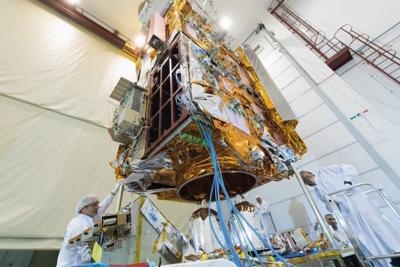Mon, Aug 21, 2017
The Third And Final Satellite Of The First Generation Of MetOp Polar-Orbiting Meteorological Satellites
The payload module of MetOp-C, developed and built by Airbus in Germany, was delivered to Toulouse after it completed a series of tests at ESTEC, the technical center of the European Space Agency (ESA) in Noordwijk, the Netherlands. The satellite, weighing in at four tonnes, is now almost complete after successful coupling of its payload and service module. In preparation for the launch scheduled for October 2018 from Kourou, French Guiana, MetOp-C will undergo a further series of radio-electric tests in the coming weeks. The solar panel, which is the last outstanding major component, will be integrated in November 2017 just before vibration testing.

The MetOp satellites have been developed by Airbus for ESA and EUMETSAT, the European Organisation for the Exploitation of Meteorological Satellites, and are part of a joint European-US cooperation. EUMETSAT is responsible for operating the satellites. MetOp-A, the first satellite in the series, was launched in October 2006 and has since doubled its specified five-year service life. MetOp-B was launched into orbit in 2012 and is also about to exceed its design service life. Initially, the plan was that each satellite would replace its predecessor, however, the excellent performance of the first two MetOp satellites means that they can now be operated simultaneously, providing the meteorological community with increased data. The forthcoming launch of MetOp-C will further improve the quality of observations and data provided for weather forecasts.
Each MetOp satellite carries a total of 12 instruments, making the system extremely versatile. The microwave humidity sounder, built by Airbus, delivers data on water vapour near the Earth’s surface and is part of the collaboration with the US. As well as each MetOp satellite carrying the instrument, two more are flying on US NOAA satellites, delivering matching data from a different orbit to enhance weather models. MetOp also measures ocean surface winds, observes sea ice distribution and monitors the ozone layer in the stratosphere, as well as relaying meteorological measurements collected by boats, buoys and research stations. It also includes a receiver to relay signals sent by persons in distress.
MetOp has enhanced the accuracy of weather forecasting and allowed extending the short-term forecasts by one day.
(Image provided with Airbus news release)
More News
States That Current Process is Damaging National Aerospace Development US Senator Jerry Morgan is pushing the FAA to speed up the process for rocket launch licensing. He argues tha>[...]
From 2015 (YouTube Edition): Model Aviator Aims For Full-Scale Career While at the 2015 Indoor Electric RC Festival, referred to as eFest, ANN CEO and Editor-In-Chief, Jim Campbell>[...]
Dave Juwel's Aviation Marketing Stories ITBOA BNITBOB ... what does that mean? It's not gibberish, it's a lengthy acronym for "In The Business Of Aviation ... But Not In The Busine>[...]
Aero Linx: Cardinal Flyers Online The Cardinal Flyers Online Web site was created and is maintained by me, Keith Peterson. My wife Debbie and I have owned a 1976 RG since 1985. Wit>[...]
Clearance Void If Not Off By (Time) Used by ATC to advise an aircraft that the departure release is automatically canceled if takeoff is not made prior to a specified time. The exp>[...]
 Senator Pushes FAA to Accelerate Rocket Launch Licensing
Senator Pushes FAA to Accelerate Rocket Launch Licensing Classic Aero-TV: RJ Gritter - Part of Aviations Bright New Future
Classic Aero-TV: RJ Gritter - Part of Aviations Bright New Future Aero-FAQ: Dave Juwel's Aviation Marketing Stories -- ITBOA BNITBOB
Aero-FAQ: Dave Juwel's Aviation Marketing Stories -- ITBOA BNITBOB ANN's Daily Aero-Linx (10.27.24)
ANN's Daily Aero-Linx (10.27.24) ANN's Daily Aero-Term (10.27.24): Clearance Void If Not Off By (Time)
ANN's Daily Aero-Term (10.27.24): Clearance Void If Not Off By (Time)



